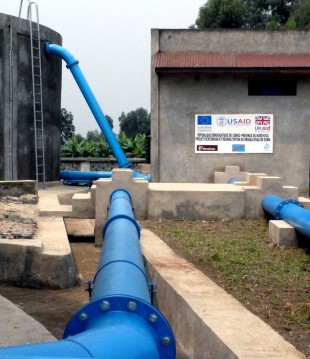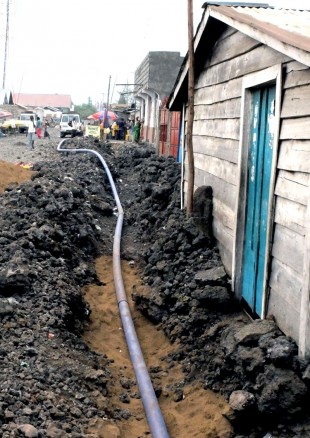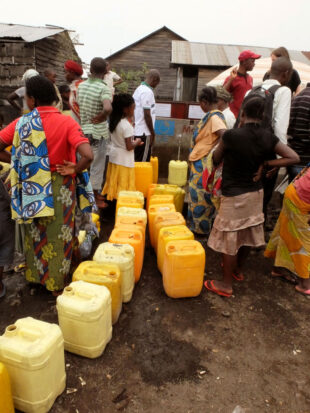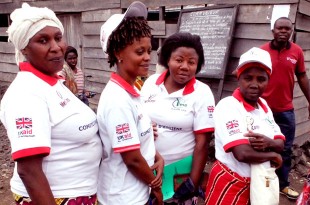Goma in the east of the Democratic Republic of Congo (DRC) must be one of the most difficult environments to deliver clean water. The city is built on the lava flows from nearby active volcanoes (the last major eruption was in 2002) making the digging of trenches for pipework a major challenge. The main source of water, Lake Kivu, is contaminated and the water is not safe to drink (though most poor people in Goma have no choice).
The rapid population expansion in Goma – particularly as a result of the conflict in North Kivu – has seen thousands of people building on marginal land with no access to safe clean water. What infrastructure there was has been destroyed in the conflict, as a result of the volcanic eruptions, or fallen into dereliction due to lack of maintenance.
Providing clean and safe water to an ever expanding urban population is therefore a major challenge. The health benefits of clean water and sanitation are well understood – but there is also an opportunity for "technical" programmes such as water and sanitation to have a significant impact on the local political economy, on poverty reduction, on empowering women and girls, and, perhaps, contribute to the reduction of conflict.

DFID DRC recently co-funded - together with United States Agency for International Development (USAID) and the European Union (EU) - a 3 year project to increase the water storage capacity in the network, and the extension of stand pipes and water fountains to under served areas of Goma North. As a result of the positive impact of this project on the lives of the inhabitants, and in particular women and girls, DFID DRC is currently funding the inception of a new 5 year project which includes the further extension of drinking water services to the population of Goma and the neighbouring town of Bukavu in South Kivu.
I went with our implementing partner, MercyCorps, down the full length of the urban water system in Goma. We started with the extraction from Lake Kivu, at which point chemicals are added to purify the water, in order to transform it into drinking water. The water is then pumped up to a reservoir at the top of Mount Goma, and then re-pumped (after laboratory analysis to determine it is safe) through 8 km of Goma to another set of reservoirs from where the secondary and tertiary pipework fans out through the poor quarters of the city. It's an impressive engineering feat. Getting water through the system remains a constant challenge as a result of poor electricity supply. By taking advantage of every moment of current – and the new storage capacity - MercyCorps can usually keep the water flowing.

Digging the trenches that carry the pipework is particularly challenging. Human labour rather than machines is used to break the rock. There is a highly organised, unionised, card-carrying group of Goma rock breakers and trench diggers. Using the rubber from old shoes which is melted into the spaces between the heated rocks, the rock breakers then pour in a combination of salt water and OMO (the exact scientific efficacy of the washing powder remains a mystery) which then shatters the rubber and splits the lava making it easier to work with.

Once the pipe work is completed, standpipes and water fountains are then strategically positioned so that (eventually) no one will have more than 250m to walk to get access to potable water.
Each water point is managed by a community water committee and staffed by a 2-person team that operate the taps and collects the money that is then reinvested in the system.
The cost of water to poor people in Goma has dropped dramatically. Previously they were dependent upon their own labour to haul water from the Lake to their homes, or buy water from private vendors at high prices. Now they have potable water at a much cheaper price closer to home. This is freeing up a lot of time and energy – particularly for women and girls – that can be used more productively.

The provision of clean water is also having an impact on the local economy – in ways that we are starting to understand through our monitoring and evaluation. It is creating clear winners as poor families can reduce their expenditure on water and reduce the amount of time that women and girls spend in collecting water. It also creates losers – with private water vendors (often some of the poorest and most vulnerable members of the community) losing their employment and source of income. The project is working with these groups to maximise the benefit and minimise the costs. If water vendors are not engaged there is a real risk that they will try and disrupt the flow of water.

It may look like a technical problem with a technical solution. But delivering clean water to urban Goma has far-reaching consequences for poor people, for women and girls, for private water sellers, for community politics, and for empowerment and accountability. Even the most technical of programmes quickly becomes a governance programme – and this has to be factored in at programme design if we and our implementing partners are to succeed.
Keep in touch. Sign up for email updates from this blog, or follow Chris on Twitter.

Recent Comments